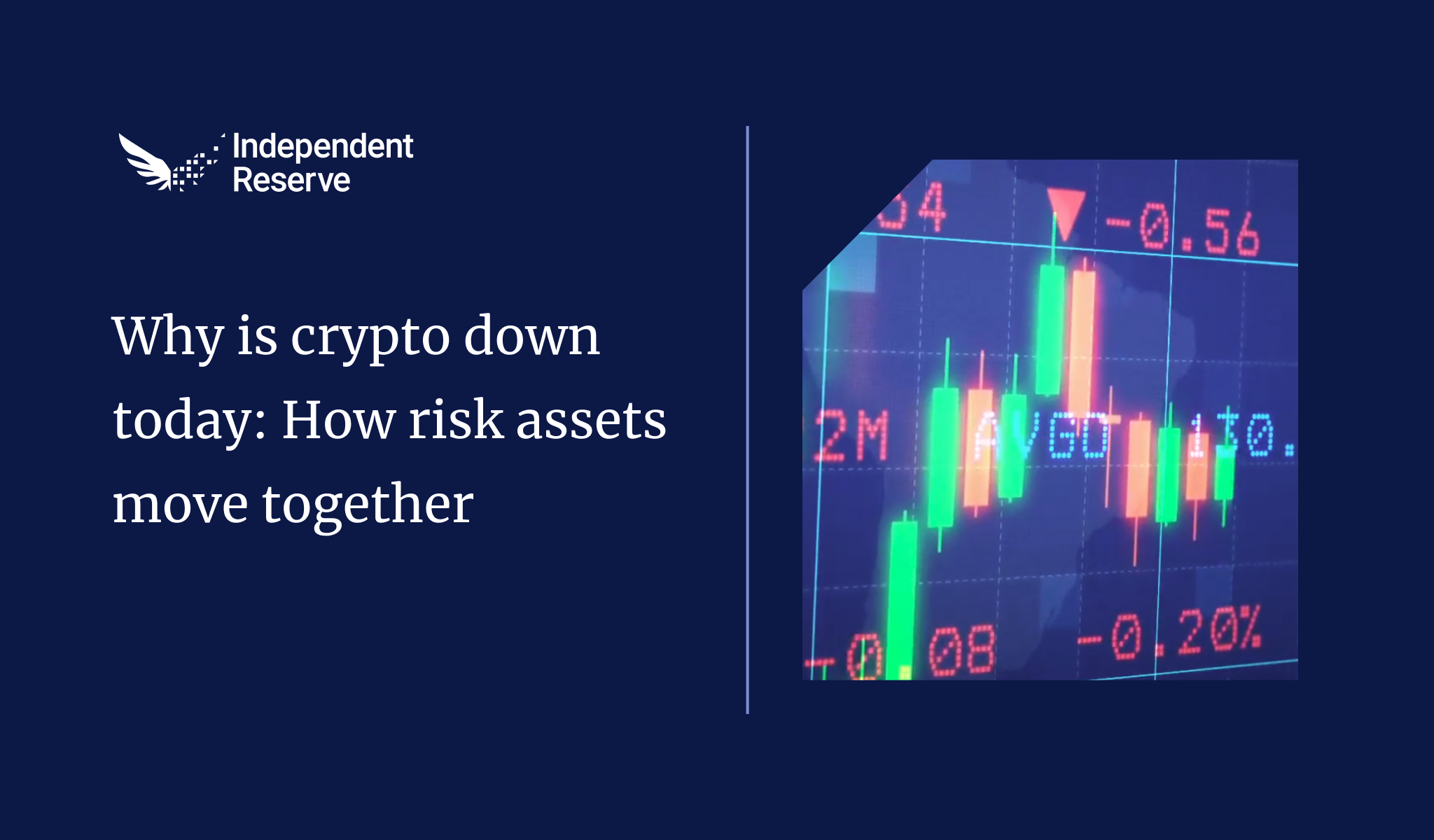In markets
Crypto markets saw a boost earlier in the week after the US Federal Reserve raised rates by the expected quarter of a percent and officials started to talk about “disinflation”. Bitcoin poked its head above US$24K (A$34.6K) while ether traded above US$1,700 (A$2,450) for the first time since September. However, the good vibes came to a halt after unexpectedly strong job numbers on Friday raised fears that rates will continue to rise. Nonfarm payroll jobs jumped 517,000 in January, much higher than the 185,000 predicted and US unemployment is now at its lowest level since 1969. Closer to home the Reserve Bank is expected to raise interest rates again today. Bitcoin finishes the week down 4.1% to trade at A$32,760 (US$22,755) while ether was down 1% to A$2,333 (US$1,620). XRP lost 3.5%, Cardano was relatively flat, Doge gained 2.6% and Polygon was also up, by 2.2%. The Crypto Fear and Greed Index is at 56 and has been at ‘greed’ for the past week.

From the OTC desk
Last week the Bank of England (BoE), the European Central Bank (ECB) and the US Federal Open Market Committee (FOMC) all increased their underlying cash rates (50bps; 50bps; and 25bps respectively).
Federal Reserve Chair Jerome Powell highlighted that he “didn’t expect to cut interest rates this year” and that “core services inflation (excluding housing) has yet to experience disinflation”. The reduced pace of interest rate increases was welcomed by risk assets and cryptocurrencies, with the recognition by Chair Powell that disinflation was now present.
Today, the Reserve Bank of Australia has also increased the cash rate by 25bps, to 3.35%, following a Q4 inflation reading of 7.8%. In the Meeting Statement today, Governor Philip Lowe highlighted that:
The Board expects that further increases in interest rates will be needed over the months ahead to ensure that inflation returns to target and that this period of high inflation is only temporary. In assessing how much further interest rates need to increase, the Board will be paying close attention to developments in the global economy, trends in household spending and the outlook for inflation and the labour market.
In global markets, US bond prices continue to be leading for both traditional risk assets and cryptocurrencies. Last Friday, the US Non-Farm Payrolls data for January showed a 517k increase in jobs for the month. This result was nearly three times the consensus estimate for job gains! And saw the US unemployment rate move from 3.6% down to 3.4% – the lowest US unemployment rate in 53 years!
History would suggest that such a tight labour market was unlikely to deliver moderating wage inflation. US treasury bond price action post the release also suggested a similar concern – with the yield on the 10yr US Treasury bond moving from 3.40% up to 3.60%.
In cryptocurrencies, the positive price action of January has stalled, with higher bond yields adjusting the prices of risk assets. ETH/BTC has moved above 0.0700 on the week – expect this cross to gain significant attention on approach to the Ethereum Shanghai upgrade (expected in March 2023). Flows on the desk continue to indicate a large amount of interest in Defi, with notable buying of USDT. USDT remains trading near the 1:1 USD peg and has not shown signs of credit/market stress for a number of weeks now. Last week we highlighted buying interest in SOL, AVAX and MATIC. This has continued.
For any further information, please feel free to reach out.
Headlines
How do Singapore and Sydney rate as crypto hubs?
London, Dubai and New York have been ranked as the world’s top three crypto hubs on Recap’s annual list. With 800 crypto companies and 2,173 employees, London dominates the list. Singapore comes in at a very respectable fourth place with 800 companies and more than 1,000 workers. Sydney squeaked into the top 20 at number 18 with 188 companies and 363 workers.
Token mapping
The Australian Treasury released a consultation paper on its ‘token mapping’ exercise on February 4, with submissions open for the next four weeks. The paper proposed a series of definitions about everything from tokens to smart contracts and crypto networks as well as its taxonomy of four types of crypto-related products: crypto asset services (exchanges, trading, minting, staking as a service), intermediated crypto assets (business, rights or IP tokens, stablecoins), network tokens (Bitcoin and Ethereum) and a spectrum of intermediated to public smart contracts. The paper anticipates existing laws can be tailored fairly easily to large parts of the crypto ecosystem. Treasurer Jim Chalmers and Assistant Treasurer Stephen Jones put out a statement saying the token mapping exercise was one part of a three-part plan to better regulate crypto. The other parts include strengthening enforcement by increasing the resources of ASIC’s digital assets team and increasing prosecutions, and bolstering consumer protection by providing new real-time data-sharing tools to the ACCC to help it identify and prevent crypto scams.
UK’s 80 page crypto regulation report
Meanwhile, in the UK, HM Treasury published its own long-awaited consultation paper for crypto regulation. The 80-page document states there will not be a separate regulatory regime for crypto which will fall under the U.K.’s Financial Services and Markets Act 2000 (FSMA). However, the rules will be tailored to suit the unique aspects of the digital assets market. Interestingly, algorithmic stablecoins won’t be banned outright but they will be banned from claiming to be ‘stable’. The consultation closes on April 30.
New CEO for Independent Reserve Singapore
Independent Reserve has named co-founder Lasanka Perera as CEO for Singapore. He’ll take over from managing director Raks Sondhi who is leaving the firm in February to pursue other professional opportunities. Perera will retain his role as group chief operating officer (COO).
Decentralised social media on the app store
The Nostr network-connected app Damus has finally been added to the iOS app store after being knocked back numerous times. Nostr is a decentralised alternative to Twitter, that’s uncensorable and enables users to easily fire Bitcoin Lightning payments to each other. The Chinese Government promptly banned it from the local app stores. Android users can access the similar Amethyst app.
That darn Australian
Australian Satoshi claimant Craig Wright has succeeded in getting a court to hear his lawsuit against Bitcoin developers. The BSV chief scientist hopes to force the devs to change the Bitcoin code so he can recover funds allegedly lost in a hack. The case was dismissed last year, but the court of appeals decided Wrights’s case had a “realistic argument” that crypto is entrusted to developers and they could be forced to introduce code that moves the owner’s Bitcoin to a safe location. In the unlikely event he wins, Bitcoin would likely fork rather than accept court-ordered code changes, but it would be a massive bomb thrown at the space.
Unstable coin
Cardano’s new algorithmic stablecoin Djed launched last week and within the first two days, more than 1.85 million coins were minted and the protocol achieved 800% collateralization. However, it briefly lost its peg with USD by falling to 97.5C on Feb 2. While it seems to have simply been teething troubles, there’s much nervousness about even over-collateralized algo stablecoins following the collapse of Terra Luna.
Crypto has a win in court
The crypto ecosystem had something of a win against the US SEC this week when XRP-adjacent lawyer John Deaton persuaded the judge in the LBRY case that secondary sales of a token do not constitute securities. The LBRY case was similar to the ongoing XRP case, and while LBRY was found to have sold unregistered securities, the judge agreed the finding does not apply to subsequent transactions of those tokens. This means even if Ripple loses its case, community-owned XRP may not be classified as a security as a result.
Bitcoin bear market ends on Monday?
Blockworks editor David Canellis has crunched the numbers and says that if Bitcoin stays above US$18.8K (A$27.2K) until Feb 13, it means the second longest bear market in history after Crypto Winter 2018 will have officially ended. He defines a bear market as beginning when an asset trades 20% below its recent high for two months and ends after it has risen 20% or more above its recent lows for one month or more.
Until next week happy trading!


